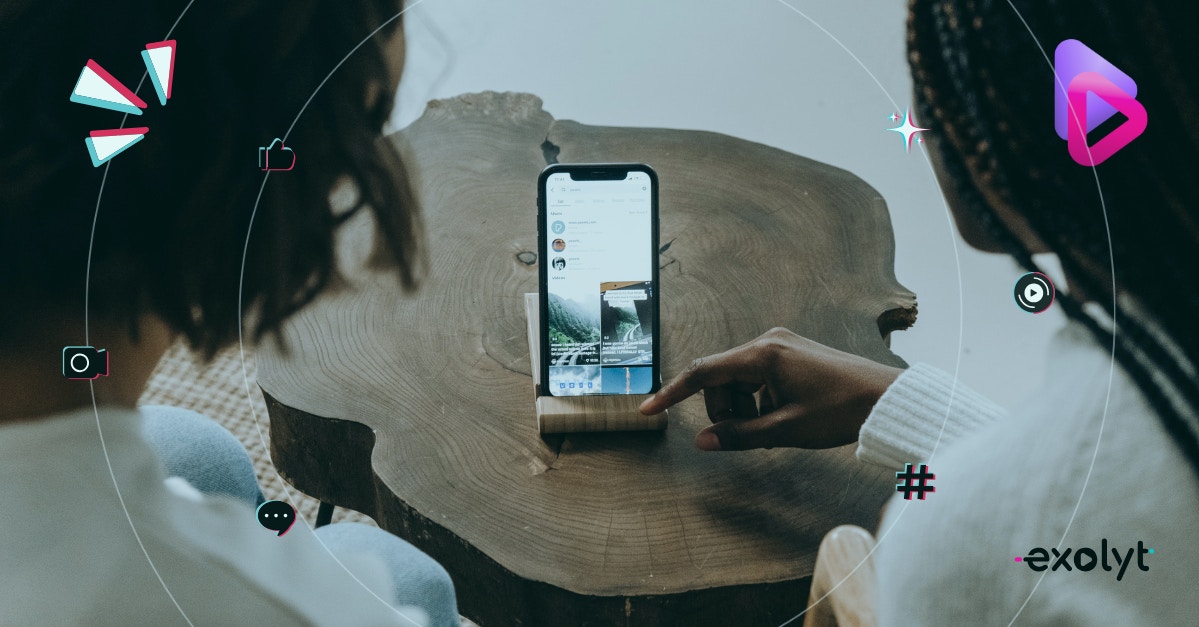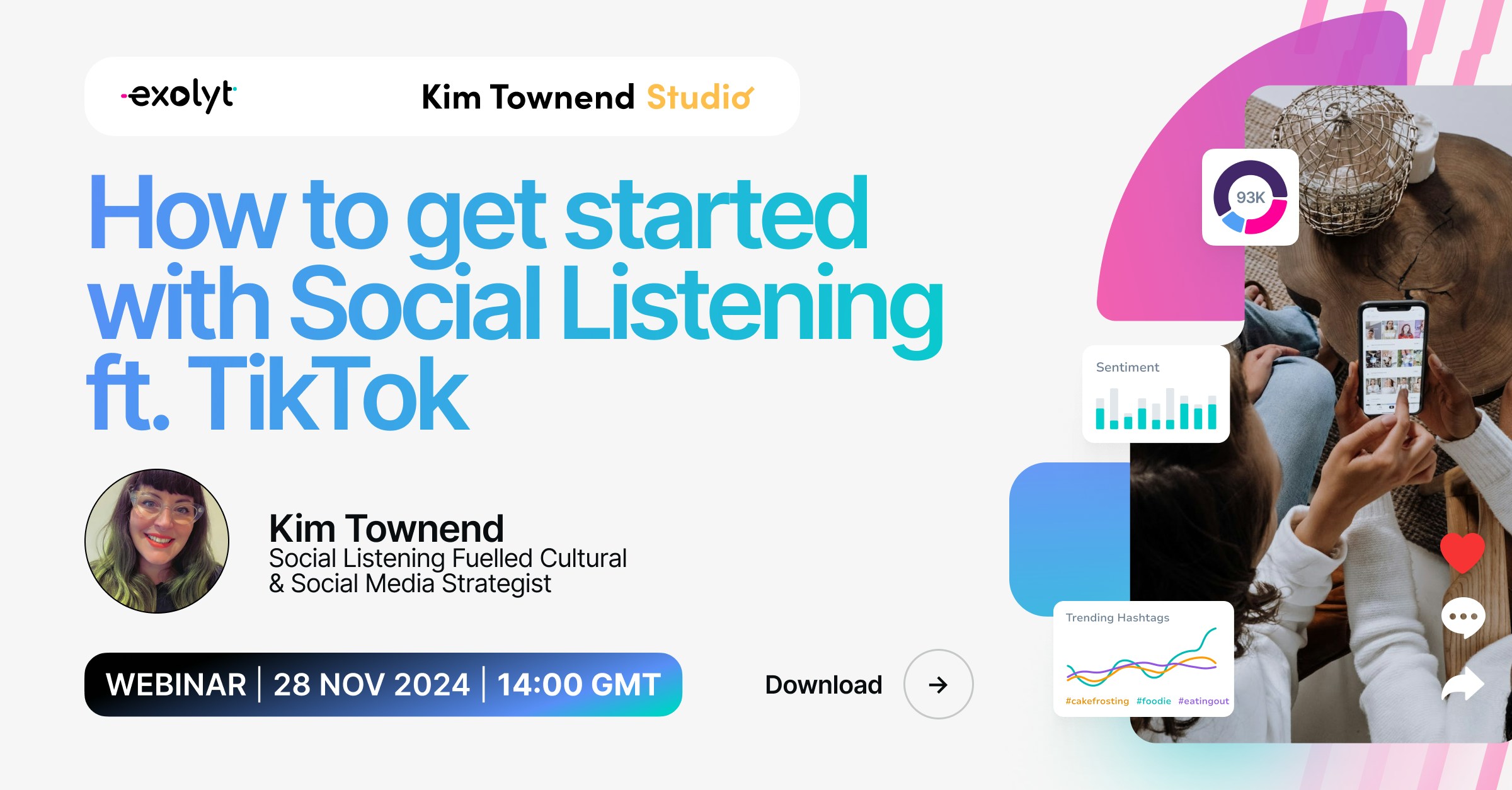TikTok represents massive potential for companies and organisations. The social media app makes it easy to engage with customers, find new ones, and build long-term brand loyalty. In the past years, TikTok has grown incredibly fast and is estimated to reach 2.35 billion users by 2029. But if you want to leverage the platform, you must understand how it works.
Social listening lets you better understand the consumer's voice, capture nuanced trend signals, and anticipate future trends. It helps you connect with your audience, powered by insights into their interests, preferences, and lifestyle.
A clear TikTok Social Listening strategy will help you grow your audience and turn followers into customers. We put together this guide to help you start, refine, and elevate your TikTok social listening.
What is social listening on TikTok?
Old-school social media marketing looked primarily at quantitative data: How many views did a video get? Did we get a lot of likes? What’s the engagement rate? While all of this quantitative data can be insightful and has its place, to be successful at creating content for TikTok, you need to go deeper.
Social listening goes beyond surface-level metrics and uncovers an audience's needs, wants, and pain points. It provides a broader perspective on user sentiments and how they engage with your brand, products, industry, and competitors. Social monitoring, often synonymously used, focuses on tracking, discovering, and observing brand mentions, tags, and queries across social media platforms, blogs, forums, and review sites.
If you want to explore the topic further, check out our blog post about the difference between social monitoring and social listening.
With its large user base and wealth of audience insights, TikTok has emerged as a community-orientated hub for the confluence of subcultures, microtrends, and shifting behaviours. Following the patterns of community movements on TikTok can help determine what’s coming next or has the potential to grow into something big and impactful.
This brings us to the next point: the importance of TikTok social listening.
Why is TikTok social listening important?
- TikTok is the fastest-growing social media platform: It’s not just used by Gen Z and Alpha: 30.6% of its users are older than 35.
- TikTok sets trends: TikTok not only sets trends in the app but also affects overall culture. With its success, Meta decided to introduce reels, and even LinkedIn introduced a short-form video format in 2024. However, most trends still start on TikTok before they seep onto the other platforms.
- TikTok users are much more engaged: TikTok users have an average engagement rate of 2,65% by followers. Coming in next (and far behind) is Instagram, with an average engagement rate by follower count of just 0.70%.
- TikTok Shop is a potential revenue generator: 71,2% of TikTok shop users have bought something after seeing it in their feed.
If you want to avoid getting left behind and miss out on opportunities for your business, you need to do social listening on TikTok.
While it may seem straightforward, the benefits of social listening are more nuanced. As shared by Jazmin Griffith, Social Listening Analyst at Pepsico - “... Social listening isn’t a vibe check—it’s your cheat code. It shows you what people want before they even know they want it. It’s how you spot trends before they hit your FYP and risks before they hit your inbox.”
Check out her five questions that social listening can answer to understand why it is important.

5 steps to master your TikTok social listening journey:
- Set clear goals
- Identify your TikTok audience
- Choose what you want to listen to
- Define the right metrics and KPIs
- Find the right tool for your needs
- Analyze your listening data for actionable insights
1. Set clear goals
Before starting social listening, it's important to clearly define your goals for this exercise. With the vast amount of data available, it's easy to become overwhelmed. By setting specific goals, you'll be better equipped to determine what you want to achieve and how to measure your success.
Some of the most common goals for a TikTok social listening strategy are:
- Conduct market research: TikTok, with its extensive user base, has become a massive hub that cultivates insights about your audience, competitors, and the state of your industry. Social listening helps capture the insights and trends most relevant to your business.
- Boost product development: Social listening can be a valuable tool for brands looking to boost their product development efforts. This is because by listening to customers' feedback on social media, brands can gain insights into product features, improvement, and new product ideas that can better meet the target audience's needs.
- Promote influencer marketing: TikTok’s algorithm fuels interest and discovery-based content for an audience that values authentic and mission-driven brands. Social listening can help you identify influencers and advocates who can promote their products and services, increase awareness to help companies connect with users, and gain trust.
- Crisis management: The short video content format makes it easy to point, shoot and post and then the video is live for the world to watch. While this is great for increasing visibility and engagement - it can be damaging if not monitored timely and proactively! While opinions may be beyond a brand’s control, social monitoring and listening can help as an effective tool for a certain degree of reputation management.
- Explore competitive advantage: Social listening can help brands gain a competitive advantage by helping them identify emerging industry trends and opportunities and differentiate through innovation and compelling offers.
- Content ideation: TikTok is now one of the most used search engines—a report by Adobe in 2024 showed that over two in five Americans use TikTok as a search engine. Social listening helps identify the key talk points, trends, and keywords most relevant to your industry so you can package them and capitalize on them timely, organically, and effectively.
- Identifying audience on TikTok: More on this in the next topic
Check out the blog below to understand the key benefits of social monitoring and listening so you can select the goals that best suit your needs.
2. Identify your TikTok audience
Every good marketing strategy starts with understanding your ideal audience: who they are, what they care about, and where and how they engage. Audience identification can also be one of your goals for social listening; in that case, your social listening exercise may end here.
You can utilize social listening to capture insights on this audience in multiple ways through Exolyt:
- Follower demographics: Discover your brand or competitor account audience demographics to understand where they are located, their gender, and their age.
- UGC social listening: Build social listeners for your brand, competitors or industry-relevant topics on Exolyt to discover your share of voice, comments, audience sentiments, and creators overview for a clear overview of how they feel and what they say.
- Industry trends: Explore industry trends relevant to your business and in specific geographies to understand which accounts (brands, influencers, or celebrities) are involved in the discussions and what they post about.
- Community-specific categories: On TikTok, communities often unite around hashtags that end in ‘tok’, and there is usually a 'tok' for everything on TikTok. If you are aware of the category of discussions that your brand or industry belongs to, you can check for that hashtag on Exolyt and find overlapping conversations (aka hashtags relations network) by region and volume to capture niche audience insights.
- Brand mentions: Looking up brand mentions made by your competitor or industry-specific influencer accounts gives you an understanding of which accounts they are working with and their follower analytics. This gives you an idea of your audience and what collaborations they want to see.
3. Choose what you want to listen to
TikTok is a goldmine of insights, but effective social listening starts with knowing what to track. Whether you're monitoring brand mentions, industry trends, or cultural shifts, defining your focus areas will help you extract valuable and actionable data. Here’s how to narrow down what to listen to on TikTok:
- Track brand mentions & conversations: Do you want to know what people say about your brand? Monitor direct mentions, hashtags, and branded challenges to gauge customer sentiment and identify engagement opportunities.
- Follow industry & competitor trends: Monitoring competitors and industry movements can help you spot emerging trends, successful campaign strategies, and consumer preferences, giving you a competitive edge.
- Identify viral trends & hashtags: TikTok thrives on trends, and early detection can help you capitalize on viral content. Follow trending sounds, challenges, and formats to keep your strategy fresh and relevant.
- Monitor influencers & key opinion leaders: Creators drive TikTok culture. Tracking influencers and industry experts allows you to see which voices shape conversations and where brand collaborations could make an impact.
- Understand audience sentiment and feedback: Social listening isn’t just about what’s popular—it’s about how people feel. Analyze comments, reviews, and discussion patterns to understand audience perception and adjust your messaging accordingly.
By defining your listening focus, you can cut through the noise and extract meaningful insights from TikTok.
4. Define the right metrics and KPIs
It’s easy to fall into vanity metrics when analysing TikTok: how many followers you have, how many views, etc. While these can be useful in social monitoring and performance tracking, social listening is more nuanced than just tracking mentions and counting comments. It’s how you hear what your audience tells you—qualitatively and quantitatively.
So, defining how you want to track and measure the insights you capture from social listening is important. You should set a few strategic KPIs based on your goals in step 1—increasing brand awareness, identifying key influencers, or exploring new trends in your content—or topics you choose to listen to in step 3.
Example:
- Positive brand mentions can be an effective KPI if your goal is to increase brand awareness.
- Consumer intelligence metrics like share of voice, sentiments, or audience demographics are important to monitor to understand your audience.
- Hashtag growth graphs with exact peaking points to understand if it's a real-time or saturating trend.
Check out our blog post on building a TikTok social listening strategy to uncover the key metrics that should take centre stage in your social listening strategy. This will give you a comprehensive understanding of your brand's online impact.
These metrics stand out as critical indicators of success and encapsulate the pulse of your online presence, offering invaluable insights into the effectiveness of your efforts.
5. Find the right tool for your needs
With TikTok shaping cultural trends and consumer conversations, choosing the right social listening tool is crucial for brands, marketers, and analysts. However, the platform has a huge amount of content, and it can be hard to track what is being said about your brand, product, and services. Additionally, not all tools offer the same level of insight, so asking the right questions can help you make the best choice.
- Start by evaluating what data you need. Are you tracking brand mentions, trends, influencer activity, or competitor strategies? Not all platforms provide in-depth TikTok analytics, so ensure the tool covers hashtags, sounds, engagement metrics, and sentiment analysis.
- Next, ask about global tracking capabilities. TikTok trends are borderless, and even if a ban affects certain regions, insights from other markets remain valuable. Can the tool track trends internationally? Can it provide historical data for long-term analysis?
- Another key factor is customization and reporting. Does the tool filter insights based on location, industry, or user behaviour? Can you easily export data for reporting?
- Think about team collaboration. The best tools allow multiple team members to access, share, and analyze insights, ensuring that marketing, strategy, and content teams stay aligned.
- Consider integration and ease of use. Does it work with other analytics tools? Is it user-friendly for quick insights?
- Lastly, consider your budget. Your budget will affect which tools are suitable. Some tools are made for large enterprises, others for small businesses. Additionally, most social listening tools have a TikTok component, while some tools, such as Exolyt, specialise in TikTok, which you also need to consider when budgeting based on your requirements.
The right tool should not just collect TikTok data but transform it into actionable intelligence. Exolyt helps you do just that.
If you want a specialized TikTok tool that is easy for your team, you can get started for free with Exolyt.
6. Analyze your listening data for actionable insights
By now, you should have collected quite a bit of data. But data is only as good as the insights you can gain from them. Here are some best practices on how to turn your data into actionable insights:
- Find a competitive edge: Compare your brand’s presence against competitors by analyzing their viral content, campaign success, customer feedback and, influencer collaborations and engagement rates. Use this data to adjust your positioning and differentiate your brand.
- Discover brand advocates and UGC creators: Social listening can help you identify influencers who align with your brand by analyzing engagement, audience demographics, and content themes to build strategic partnerships for authentic promotion.
- Leverage your audience's suggestions: Social media is not just a place where you post and ghost. The comment section of your posts is filled with great ideas and feedback. Your audience might inspire your next video or suggest a new product development strategy.
- Optimize your content strategy: Analyze engagement patterns to understand what content formats, themes, and sounds resonate most with your audience. Use this to refine your TikTok videos, ad creatives, and influencer collaborations.
- Discover emerging trends before they peak: By tracking trending hashtags, sounds, and industry-insights, you can spot viral content early within niche geographies and incorporate it into your marketing strategy before it reaches saturation.
(With Exolyt you can also segment this analysis based on location and content matrix—a feature that reveals how specific accounts have used some industry-relevant hashtags/topics and where it is currently positioned in the matrix among: unique content with high engagement, unique content with low engagement, saturated trend with low engagement, saturated trend with high engagement.)
- Improve customer engagement and brand sentiment: By analyzing comments, engagement patterns, exo scores, and sentiments on videos, you can gauge audience perspectives, address concerns, and refine messaging to foster positive brand perception.
- Predict future consumer behaviours: Social listening provides a window into historical TikTok data and behavioural patterns. You can utilise this data to anticipate shifting consumer preferences and proactively adjust marketing strategies.
How brands are using TikTok Social Listening: Examples
Example 1: Chipotle
In 2022, two TikTok creators went viral with their steak quesadilla hack for Chipotle: they added fajita veggies and a DIY sauce mixing sour cream and honey vinegar. But the fajita quesadilla wasn’t actually on the menu. The Chipotle social media team listened to over 90k organic social mentions that asked them to turn this hack into a real product.
They teamed up with the influencers to fast-track, turning the online hack into a menu item. Once it was ready, they trained 100.000 employees and even updated the app flow to introduce this new item. At the launch, the new quesadilla doubled Chipotle’s entire Quesadilla business.
What’s smart about this: Chipotle usually takes years to introduce a new menu item, but in this case, they accelerated the process due to the huge demand from TikTok. Instead of doing a simple sponsored post with the original TikTok creators once the new menu item was ready, Chipotle included the influencers and their followers in adding it to keep the audience engaged and interested.
Example 2: Duolingo
Duolingo is one of the most successful brands on TikTok. Their social media team uses social listening to monitor user mentions and trends. Through social listening on TikTok, their team discovered many users made a viral joke about the brand’s owl mascot, pushing people to complete their language lessons. The brand decided to lean into the joke and partnered up with content creators to create videos where the owl humorously stalked them.
What’s smart about this: The social media team analysed how their brand mascot is perceived and leaned into what was already a trend on TikTok. By partnering up with content creators in their industry, they showed that they can make fun of themselves.
@judyhoppsl0vr69 Do your lessons. @Duolingo #duolingopartner
♬ original sound - Bradley Uppercrust III
Conclusion
As TikTok continues to shape digital culture, social listening is no longer optional—it’s essential. Understanding audience sentiment, tracking trends, and leveraging influencer insights can help brands stay competitive in an ever-evolving landscape.
By using the right tools and strategies, businesses can turn TikTok data into actionable insights, driving smarter marketing decisions, stronger engagement, and long-term growth. Whether you're monitoring brand mentions, analyzing competitors, or spotting emerging trends, TikTok social listening in 2025 is your key to staying ahead.
Get started with TikTok social listening on Exolyt
Get started with a free 7-day trial, or connect with our team to learn more about the platform's features and potential use cases.






